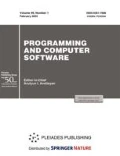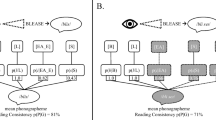Abstract
This paper investigates some specific features of continuous user identification based on hidden monitoring of keystroke dynamics when creating a free text. Our analysis of static identification approaches does not reveal any significant limitations on their application to continuous identification. The main feature of continuous identification is the method for collecting dynamic information about key presses and the correction of templates of registered users. The effectiveness of including additional classification features in recognition algorithms, e.g., those associated with the frequency of letters in texts, is demonstrated. A software application is developed to collect and analyze keystroke rhythm samples of users. Research in the domain of users with good computer skills shows quite satisfactory user recognition accuracy (87% on average). Moreover, the accuracy does not depend on the metric distance selected for recognition and improves with the use of scaling factors for letter frequency.









Similar content being viewed by others
REFERENCES
Yampolskiy, R.V. and Govindaraju, V., Behavioural biometrics: A survey and classification, Int. J. Biom., 2008, vol. 1, no. 1, pp. 81–113.
Handbook of Biometrics, Jain, A., Flynn, P., and Ross, A., Eds., New York: Springer, 2007.
Vasil'ev, V.I., Lozhnikov, P.S., Sulavko, A.E., and Eremenko, A.V., Technologies for hidden biometric identification of users of computer systems (review), Vopr. Zashch. Inf., 2015, vol. 110, no. 3, pp. 37–47.
Bergadano, F., Gunetti, D., and Picardi, C., User authentication through keystroke dynamics, ACM Trans. Inf. Syst. Secur., 2002, vol. 5, no. 4, pp. 367–397.
Karnan, M., Akila, M., and Krishnaraj, N., Biometric personal authentication using keystroke dynamics: A review, Appl. Soft Comput., 2011, vol. 11, no. 2, pp. 1565–1573.
Pisani, P.H. and Lorena, A.C., Emphasizing typing signature in keystroke dynamics using immune algorithms, Appl. Soft Comput., 2015, vol. 34, pp. 178–193.
Ivanov, A.I., Biometricheskaya identifikatsiya lichnosti po dinamike podsoznatel’nykh dvizhenii (Biometric Identification Based on the Dynamics of Subconscious Movements), Penza: Penzenskii Gos. Univ., 2000.
Chang, T.Y., Dynamically generate a long-lived private key based on password keystroke features and neural network, Inf. Sci., 2011, vol. 211, pp. 36–47.
Pisani, P.H. and Lorena, A.C., A systematic review on keystroke dynamics, J. Braz. Comput. Soc., 2013, vol. 19, no. 4, pp. 573–587.
Kim, J., Kim, H., and Kang, P., Keystroke dynamics-based user authentication using freely typed text based on user-adaptive feature extraction and novelty detection, Appl. Soft Comput., 2018, vol. 62, pp. 1077–1087.
Gunetti, D. and Picardi, C., Keystroke analysis of free text, ACM Trans. Inf. Syst. Secur., 2005, vol. 8, pp. 312–347.
Messerman, T., Mustafić , S., Camtepe, A., and Albayrak, S., Continuous and non-intrusive identity verification in real-time environments based on free-text keystroke dynamics, Proc. Int. Jt. Conf. Biometrics (IJCB), 2011, pp. 1–8.
Alsultan, A., Warwick, K., and Wei, H., Non-conventional keystroke dynamics for user authentication, Pattern Recognit. Lett., 2017, vol. 89, pp. 53–59.
Kang, P. and Cho, S., Keystroke dynamics-based user authentication using long and free text strings from various input devices, Inf. Sci., 2015, vol. 308, pp. 72–93.
Ahmed, A.A., Biometric recognition based on free-text keystroke dynamics, IEEE Trans. Cybern., 2014, vol. 44, no. 4, pp. 458–472.
Alsultan, K. and Warwick, H., Keystroke dynamics authentication: A survey of free-text methods, Int. J. Comput. Sci. Issues, 2013, vol. 10, no. 4, pp. 1–10.
Joyce, R. and Gupta, G., Identity authentication based on keystroke latencies, Commun. ACM, 1990, vol. 33, no. 2, pp. 168–176.
Spillane, R.J., Keyboard apparatus for personal identification, Tech. Discl. Bull., 1975, vol. 17, no. 3346.
Crawford, H., Keystroke dynamics: Characteristics and opportunities, Proc.8th Annu. Int. Conf. Privacy Security and Trust (PST), 2010, pp. 205–212.
Peacock, A., Ke, X., and Wilkerson, M., Typing patterns: A key to user identification, IEEE Secur. Privacy, 2004, vol. 2, no. 5, pp. 40–47.
Shanmugapriya, D. and Padmavathi, G., A survey of biometric keystroke dynamics: Approaches, security and challenges, Int. J. Comput. Sci. Inf. Secur., 2009, vol. 5, no. 1, pp. 115–119.
Banerjee, S.P. and Woodard, D.L., Biometric authentication and identification using keystroke dynamics: A survey, J. Pattern Recognit. Res., 2012, vol. 7, no. 1, pp. 116–139.
Teh, P.S., Teoh, A.B., and Yue, S., A survey of keystroke dynamics biometrics, Sci. World J., 2013, pp. 1–24.
Mondal, S. and Bours, P., A study on continuous authentication using a combination of keystroke and mouse biometrics, Neurocomput., 2016, vol. 230, pp. 1–22.
Krutokhvostov, D.S. and Khitsenko, V.E., Password and continuous authentication based on keystroke dynamics by means of mathematical statistics, Vopr. Kiberbezop., 2017, vol. 24, no. 5, pp. 91–99.
Kochegurova, E.A., Luneva, E.E., and Gorokhova, E.S., On continuous user authentication via hidden free-text based monitoring, Adv. Intell. Syst. Comput., 2019, vol. 875, pp. 66–75.
Vinayak, R. and Arora, K., A survey of user authentication using keystroke dynamics, Int. J. Sci. Res. Eng. Technol.(IJSRET), 2015, vol. 4, no. 4, pp. 378–384.
Teh, P.S., Zhang, N., Teoh, A.B., and Chen, K., A survey on touch dynamics authentication in mobile devices, Comput. Secur., 2016, vol. 59, pp. 210–235.
Mahfouz, A., Eldin, A.S., and Mahmoud, T.M., A survey on behavioral biometric authentication on smartphones, J. Inf. Secur. Appl., 2017, vol. 37, pp. 28–37.
Corpus, K.R., Gonzales, R.J., Morada, A.S., and Vea, L.A., Mobile user identification through authentication using keystroke dynamics and accelerometer biometrics, Proc. Int. Conf. Mobile Software Engineering and Systems (MOBILESoft), 2016, pp. 1–12.
Sokolov, D.A., Using keystroke dynamics for authentication in distributed systems with mobile clients, Bezop. Inf. Tekhnol., 2010, no. 2, pp. 50–53.
West, A.G., Analyzing the keystroke dynamics of web identifiers, Proc. ACM Web Science Conf. (WebSci), 2017, pp. 181–190.
Pentel, A., Predicting age and gender by keystroke dynamics and mouse patterns, Proc. 25th Conf. User Modeling, Adaptation, and Personalization (UMAP), 2017, pp. 381–385.
Lozhnikov, P.S., Sulavko, A.E., Buraya, E.V., and Pisarenko, V.Yu., Authentication of computer users based on keystroke dynamics and facial features, Vopr. Kiberbezop., 2017, vol. 21, no. 3, pp. 24–34.
Morales, A., Fierrez, J., Tolosana, R., Ortega-Garcia, J., Galbally, J., Gomez-Barrero, M., Anjos, A., and Marcel, S., KBOC: Keystroke biometrics ongoing competition, Proc. 8th IEEE Int. Conf. Biometrics: Theory, Applications and Systems, 2016, pp. 1–6.
Vorona, V.A. and Tikhonov, V.A., Sistemy kontrolya i upravleniya dostupom (Access Control Systems), Moscow: Goryachaya liniya – Telekom, 2010.
Berthold, M., Borgelt, C., Hopner, F., and Klawonn, F., Guide to intelligent data analysis, Texts Comput. Sci., London: Springer, 2010, vol. 42.
Gaines, R.S., Lisowski, W., Press, S.J., and Shapiro, N., Authentication by keystroke timing: Some preliminary results, Technical Report R-2526-NSF, Rand Corporation, 1980.
Ali, M.L., Monaco, J.V., Tappert, C.C., and Qiu, M., Keystroke biometric systems for user authentication, J. Sign. Process. Syst., 2017, vol. 86, pp. 175–190.
Kochegurova, E.A., Gorokhova, E.S., and Mozgaleva, A.I., Development of the keystroke dynamics recognition system, J. Phys.: Conf. Ser., 2017, vol. 803, no. 1, pp. 1–6.
Alpar, O., Frequency spectrograms for biometric keystroke authentication using neural network based classifier, Knowl.-Based Syst., 2017, vol. 116, pp. 163–171.
Goodkind, A., Brizan, D.G., and Rosenberg, A., Utilizing overt and latent linguistic structure to improve keystroke-based authentication, Image Vision Comput., 2017, vol. 58, pp. 230–238.
Dozono, H., Ito, S., and Nakakuni, M., The authentication system for multi-modal behavior biometrics using concurrent Pareto learning SOM, Proc. 21st Int. Conf. Artificial Neural Networks, 2011, part II, pp. 197–204.
Popovici, E.C., Guta, O.G., Stancu, L., Arseni, S.C., and Fratu, O., MLP neural network for keystroke-based user identification system, Proc. 11th Int. Conf. Telecommunication in Modern Satellite, Cable and Broadcasting Services (TELSIKS), 2013, vol. 1, pp. 155–158.
Maxion, R.A. and Killourhy, K.S., Keystroke biometrics with number-pad input, Proc. IEEE/IFIP Int. Conf. Dependable Systems and Networks (DSN), 2010, pp. 201–210.
Funding
This work was supported by the Russian Foundation for Basic Research, grant no. 18-07-01007.
Author information
Authors and Affiliations
Corresponding authors
Additional information
Translated by Yu. Kornienko
Rights and permissions
About this article
Cite this article
Kochegurova, E.A., Martynova, Y.A. Aspects of Continuous User Identification Based on Free Texts and Hidden Monitoring. Program Comput Soft 46, 12–24 (2020). https://doi.org/10.1134/S036176882001003X
Received:
Revised:
Accepted:
Published:
Issue Date:
DOI: https://doi.org/10.1134/S036176882001003X




